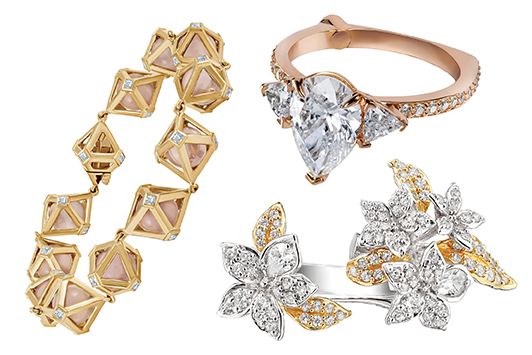
Each week seems to bring a new story about a designer dabbling in lab-grown diamonds, with creations ranging from the simple solitaire to red-carpet mimicry, millennial minimalism to outlandish displays of ostentation.
Starting with the ostentatious, one of last year’s most interesting designs was a collaboration between San Francisco-based producer Diamond Foundry and tech royalty. Tapping into its Silicone Valley surrounds, the lab-grown-diamond producer tasked Apple chief design officer Jony Ive and industrial designer Marc Newson with creating a showstopping diamond ring. They came up with a highly faceted piece made entirely of diamond, which sold for $256,000 at the Sotheby’s (RED) auction in December to raise funds for the fight against AIDS. While the idea is not entirely original — Geneva jeweler Shawish created a solid 150-carat mined-diamond ring in 2012 — it celebrates the made-to-order possibilities of lab-grown.
Spanning the spectrum
For brands engaged in less newsworthy but more marketable synthetic-diamond jewelry, design teams seem to be split between replicating tradition and embracing the future.
The bridal market is a focus for the former camp, with brands including Diamond Foundry, Brilliant Earth, Couple and Love Earth simply swapping out mined for lab-grown.
Others, such as Âme Jewelry — which opened stores in Los Angeles, California, and New York in December — are more playful. Octagonal, channel-set rings, chunky industrial cuffs and full-knuckle rings radiate the freedom of reinventing a heritage luxury commodity.
Lightbox, the lab-grown-diamond brand De Beers launched in May, has also tapped into the fashion market.
“It takes its cues from the world of cosmetics or accessories more than the world of fine jewelry,” says Lightbox chief marketing officer Sally Morrison. “It’s not about the theater of opening the velvet box, it’s about ‘I love that color pink.’ It’s like you were looking at an eyeshadow or a glass.” Indeed, pink lab-grown diamonds star in Lightbox’s selection, along with blue stones.
Easy on the ear
One of the biggest fashion trends in the fine-jewelry market is a refreshed obsession with multiple piercings and the quest for an Instagram-worthy ear stack. Once in the ear, these jewels are rarely removed, and as such, brands such as Maria Tash have found success in upselling modern piercers. With the ability to offer the same look at a lower price, this area offers potential for lab-grown-diamond designers.
Individually sold earrings, popular among millennials, are a key focus of the 20-piece debut collection from London-based lab-grown jewelry brand Kimaï, which was launched in November by the daughters of Antwerp diamond dealers. “We are targeting our generation,” says 25-year-old cofounder Jessica Warch. “We want pieces that last. We don’t want to do fashion pieces that you wear once and leave in your closet. We’re not very classic, we have a style — but it’s something you can wear every day.”
Echoing this sentiment is fellow lab-grown-diamond brand Lark & Berry, which Laura Chavez launched in 2017. It, too, has invested in the piercing craze, setting up a piercing studio at its London store, though it also offers more lavish styles. Most of its sales are of round brilliant lab-created diamonds from melee to 7 carats, says Chavez. “We are always seeking to have varied designs, ranging from everyday pieces to what you would wear at a gala.”
Rocking the red carpet
Then there are the glitz hunters who care little for understated cool. Leading the pack is Atelier Swarovski with a collection designed by actress Penelope Cruz, which launched last summer. Boasting price tags of up to $21,500, it not only took inspiration from the red carpet, but appeared on it, worn by its creator. Made with Fairtrade gold and lab-grown gems and diamonds, these jewels are feminine, flashy and full of old Hollywood glamour.
Image: Double Diamond bracelet, stephenwebster.com / Iris engagement ring, alessa.jewelry / Bellflower ring, anabelachan.comArticle from the Rapaport Magazine - February 2019. To subscribe click here.